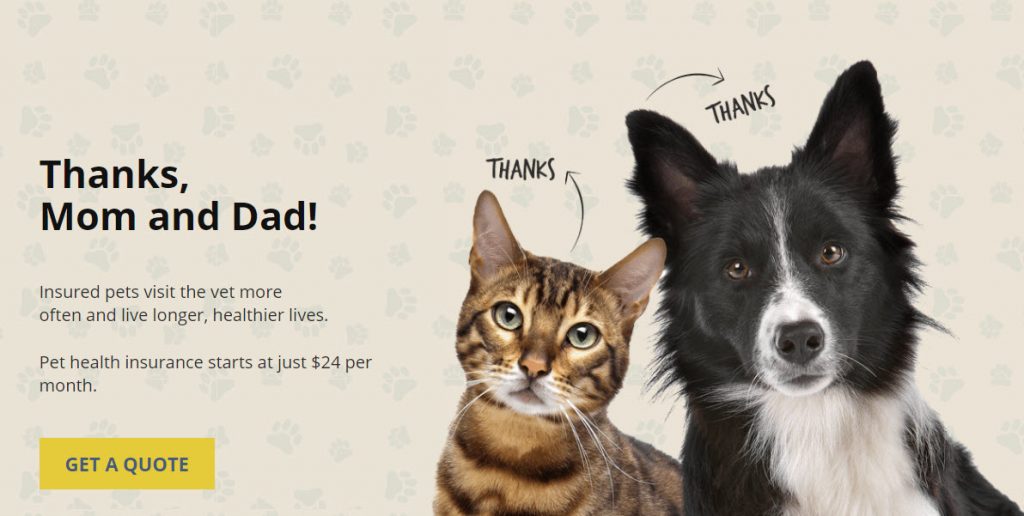The Dog Flu – Symptoms & Treatment for Canine Influenza

Free Pet Insurance Comparison
Compare Quotes From Top Companies and Save
Secured with SHA-256 Encryption
Dr. Pippa Elliott BVMS, MRCVS
Veterinarian
Dr Pippa Elliott BVMS, MRCVS is a veterinarian with over 30 years of experience in companion animal practice. In 1987 she graduated from the University of Glasgow, with a degree in veterinary medicine and surgery. She works at Blythwood Vets and the People’s Dispensary for Sick Animals (PDSA). Pippa is an advocate of Fear-Free Practice, an animal addict, and a veterinary writer. She is also w...
Veterinarian
UPDATED: Feb 3, 2025
Pet Insurance U receives compensation from the third parties included on this site. This includes payment for clicks from our site to insurance providers’ sites and quote requests generated. Our rankings and reviews are not affected by payments from the insurance companies. The compensation we receive allows the site to be free and regularly updated. Our goal is to review every pet insurance provider, but not all companies are listed on the site.
And many of the companies we review do not pay us anything. We simply rate, compare and review their plan because we feel it will be valuable to you. Our reviews are guaranteed to be unbiased, professional and advertising compensation does not influence rankings.
We are a free online resource for anyone interested in learning more about pet insurance. Our goal is to be an objective, third-party resource for everything pet insurance related. We update our site regularly, and all content is reviewed by pet insurance experts.
UPDATED: Feb 3, 2025
Pet Insurance U receives compensation from the third parties included on this site. This includes payment for clicks from our site to insurance providers’ sites and quote requests generated. Our rankings and reviews are not affected by payments from the insurance companies. The compensation we receive allows the site to be free and regularly updated. Our goal is to review every pet insurance provider, but not all companies are listed on the site.
And many of the companies we review do not pay us anything. We simply rate, compare and review their plan because we feel it will be valuable to you. Our reviews are guaranteed to be unbiased, professional and advertising compensation does not influence rankings.
On This Page
The dog flu, also known as the canine influenza virus, is usually spread throughout certain regions and passed along in waves when there is an outbreak.
While the dog flu isn’t fatal, it’s best to know what to look out for if your dog happens to get the flu or there is an outbreak where you live.
The dog flu is a respiratory disease that is very contagious and easily passed among dogs. The dog flu is caused by what is known as the influenza A virus which can also occur in humans.
There are two strains of the virus that causes dog flu: H3N8 and H3N2. Both affect the upper respiratory system and are very contagious.
Need Pet Insurance?
FACT: Pet insurance pays up to 90% of vet bills when your pet is sick or injured!
How Is The Dog Flu Contracted?
The dog flu is airborne just as it in humans.
Your dog can contract the flu by being near an infected dog that is merely coughing or barking.
The flu can also spread throughout the flu-ridden environment and even picked up by contaminated water bowls or dog collars.
Kennels, grooming places, and doggy dare care are places where a dog can contract the flu fairly easily if any of the dogs at the facilities have the flu.
The flu can even be spread even if an exposed dog has just the beginning stages of the flu and has yet to show symptoms.
Related: 10 Things You Must Know Before You Buy Pet Insurance
Enter your ZIP code below to view companies that have cheap pet insurance rates.
Secured with SHA-256 Encryption
Symptoms Of Canine Influenza
The dog flu can be either mild or more severe and can occur at any time of year.
Mild:
In more mild cases, dogs will usually have a moist cough and nasal discharge, the symptoms last from 7 to 30 days and will usually go away on its own.
Severe:
In severe cases, dogs will have a very high fever (more than 103 degrees) and will develop symptoms quickly. Pneumonia can occur because the flu affects the capillaries in your dog’s lungs. Your pup might cough up blood and breathing could be difficult.
Some dogs will also develop a bacterial infection or even bacterial pneumonia.

The general symptoms of both flu types are the following:
- Moist & Dry Cough
- Nasal Discharge
- Sneezing
- Fever
- Eyes runny
- Lethargic
- Fever
- Difficulty Breathing
Some of the symptoms of dog flu are very similar to kennel cough which primarily consists of a dry cough.
If you think your dog might have another condition other than the flu, you can take a look at our dog health guide to see what other illnesses might be occurring.
Read more: Does pet insurance cover kennel cough?
Real Cost Savings from PetFirst Clients

Luna
PetFirst saved his parents
$6,712
A happy energetic Luna one morning couldn’t hold her food down. After months of multiple costly vet visits to specialists and an endoscopy, the problem was discovered and fixed. Luna put 22 pounds back on in no time and her parents were grateful for having PetFirst by their side to pay the bills.
How To Diagnose The Dog Flu
If your dog has any of the symptoms of the dog flu, particularly when an outbreak has occurred in your region, take your dog to vet as soon as possible.
Your veterinarian will usually give your dog a physical as well as perform some blood work.
If your dog has the flu, the blood work will show a rise in your pup’s white blood cells.
X -rays might be taken to see if there is an infection or if pneumonia has developed in your dog’s lungs.
Your vet might use a bronchoscope to view your dog’s trachea to determine if there is extra unwanted bacteria or a secondary infection has developed.
Treatment For Canine Influenza
In the more mild cases of the flu, your dog is usually given cough suppressants.
If there is a secondary infection, antibiotics are given to your dogs to ward off the infection.
Your dog should be isolated from other dogs while he recovers as well as get some rest.
In the more severe cases of dog flu, your dog will be given supportive care which includes fluids, antibiotics or other forms of medication.
Your dog might have to be hospitalized until he is stable.
When your dog is back home, it is important that he remains at home and isolated from other dogs until all the symptoms are gone.
Your vet will usually provide to you the best way to quarantine your dog to prevent the flu from spreading.
Enter your ZIP code below to view companies that have cheap pet insurance rates.
Secured with SHA-256 Encryption
Prevention Of The Dog Flu Virus
The best prevention for your dog is to keep your pup away from any public park, kennel or area that has reported an occurrence of the dog flu.
If you happen to be with another dog that has the flu, make sure to wash all your clothes and hands thoroughly before touching your dog.
However, not to worry. You won’t develop the flu from your dog.
There are currently vaccines available for both strains of the dog flu.
If your dog does get the vaccine, he will need a booster shot as well a few weeks later.
Your vet might recommend the vaccine if your dog is on the road a lot or has to spend time in kennels often.
Can Pet Insurance Help With The Dog Flu?
If your dog develops the dog flu, either mild or severe, pet insurance can help pay for the diagnosis of the dog flu as well as the treatment that might be necessary.
In a severe case where your dog needs to be hospitalized, pet insurance will also pay a big percentage of the bill for the hospital stay which can be pretty darn expensive!
Pet insurance providers like Healthy Paws and Embrace will pay for up to 90% of the bill which can be very helpful.
We recommend Healthy Paws as the #1 pet health insurance provider!
Fetch Rates With Healthy Paws!
Just make sure to insure your dog while he is still young so the flu condition isn’t considered pre-existing.
Any pre-existing condition is not covered under any pet insurance plan.

Things To Keep In Mind With The Canine Flu
Your dog might develop the dog flu despite your best intentions.
However, if you notice the symptoms and bring your dog to the vet right away, you can get your dog treated and back to normal soon.
Most of the dog flu strains are not fatal but need to be treated as soon as possible.
And remember to keep your dog away from other dogs while he or she is recuperating.
Other articles you may find helpful:
Is Exotic Pet Insurance Necessary?
The Best Pet Insurance By State
Fun Facts, Dog FAQ, And Unsolicited Dog Advice
5 Training Commands to Save Your Dog’s Life
The Ultimate Guide to Safe Foods for Dogs
We get it, your dog is like your child and when your puppy or dog has health problems it is scary. Luckily there is pet insurance companies that will help you pay for any veterinarian care they made need. Checkout the best puppy and dog pet insurance companies and learn about common puppy health issues and ailments in older pets.
Common Health Problems:
Chronic Active Hepatitis in Dogs
Cruciate Ligament Tear in Dogs
Degenerative Myelopathy | Spinal Cord Disease In Dogs
Dementia in Dogs | Canine Cognitive Dysfunction
Dog Comedones (Schnauzer Bumps)
Dog Diarrhea: What Can You Do To Help?
Gallbladder Obstruction in Dogs
Heart Murmurs In Dogs | How To Identify Them
Intervertebral Disc Disease In Dogs
Nasal Solar Dermatitis In Dogs
Progressive Retinal Atrophy In Dogs
The Dog Flu – Symptoms & Treatment for Canine Influenza
Enter your ZIP code below to view companies that have cheap pet insurance rates.
Secured with SHA-256 Encryption
Frequently Asked Questions
What is the dog flu, and how is it contracted?
The dog flu, or canine influenza virus, is a respiratory disease caused by the influenza A virus (H3N8 and H3N2 strains). It spreads through the air, and dogs can contract it by being near infected dogs, sharing contaminated water bowls, or through exposure in places like kennels and grooming facilities.
What are the symptoms of canine influenza, and how is it diagnosed?
Symptoms of dog flu range from mild (moist cough, nasal discharge) to severe (high fever, pneumonia). If your dog shows symptoms during an outbreak, take them to the vet. Diagnosis involves a physical examination, blood work showing increased white blood cells, and possibly X-rays or bronchoscopy.
How is the dog flu treated?
Mild cases may require cough suppressants, while severe cases might need supportive care, including fluids, antibiotics, and hospitalization. Isolation from other dogs is crucial during recovery, and the vet will guide you on proper quarantine measures.
How can the dog flu be prevented?
Prevention involves avoiding areas with reported outbreaks, washing thoroughly if in contact with infected dogs, and getting your dog vaccinated. Vaccines are available for both H3N8 and H3N2 strains, and booster shots may be necessary.
Can pet insurance help with the dog flu?
Yes, pet insurance can cover the diagnosis and treatment costs of the dog flu, including hospitalization expenses. Providers like Healthy Paws and Embrace may cover up to 90% of the bill, making it a valuable resource for managing veterinary expenses.
What should be kept in mind regarding the canine flu?
Despite precautions, dogs may still get the flu. Early detection and prompt veterinary care are essential. While most strains are not fatal, timely treatment is crucial. Keep your dog away from other dogs during recovery.
How do I choose the right pet insurance for my dog?
When selecting pet insurance, consider coverage for illnesses like the dog flu, reimbursement percentages, and any age-related restrictions. It’s advisable to enroll your dog while they are young to avoid pre-existing condition exclusions.
What are the key symptoms of the dog flu that I should watch for?
Common symptoms include coughing, nasal discharge, high fever, and difficulty breathing. If your dog exhibits these signs, especially during a reported outbreak, consult your vet promptly for diagnosis and treatment.
Can I develop the flu from my dog?
No, you won’t catch the flu from your dog. However, if your dog is infected, take hygiene precautions to prevent the spread of the virus, such as washing your hands and clothes thoroughly.
Are there specific precautions to take if my dog is frequently in public places or kennels?
Yes, if your dog is often in public areas or kennels, consider getting them vaccinated against the dog flu. Additionally, practice good hygiene by washing your dog’s belongings and your hands to minimize the risk of infection.
Enter your ZIP code below to view companies that have cheap pet insurance rates.
Secured with SHA-256 Encryption
Dr. Pippa Elliott BVMS, MRCVS
Veterinarian
Dr Pippa Elliott BVMS, MRCVS is a veterinarian with over 30 years of experience in companion animal practice. In 1987 she graduated from the University of Glasgow, with a degree in veterinary medicine and surgery. She works at Blythwood Vets and the People’s Dispensary for Sick Animals (PDSA). Pippa is an advocate of Fear-Free Practice, an animal addict, and a veterinary writer. She is also w...
Veterinarian
We are a free online resource for anyone interested in learning more about pet insurance. Our goal is to be an objective, third-party resource for everything pet insurance related. We update our site regularly, and all content is reviewed by pet insurance experts.
